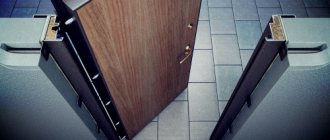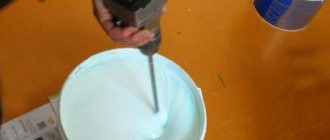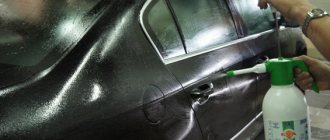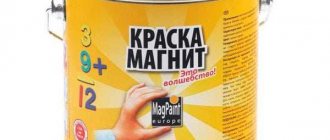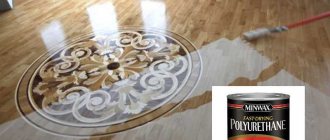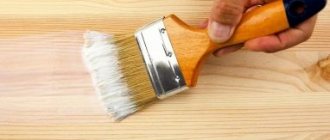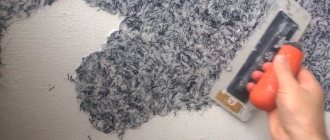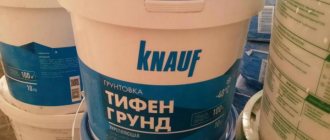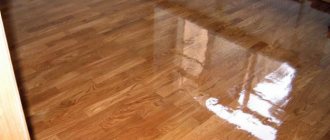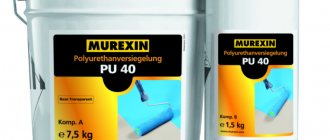How to dilute the primer
Most soil mortars can be purchased at specialty hardware stores. Often, primer products are presented in the form of dry primer that needs to be stirred. The most concentrated ones can be thoroughly diluted and applied to the surface of the walls. We will learn how to dilute the primer correctly from our article.
What to use as a thinner for different types of primers
Soil varies in its various properties and uses. In this case, the following stand out:
- Strengthening type.
- Increasing type (adhesion).
Let's find out how to properly dilute the primer.
1. Acrylic is also called dispersion or emulsion. This type is considered universal, as it is used for all types of wall surfaces and ceilings. The acrylic solution is diluted with water. Acrylic can also be a primer.
Cannot be used on metal as it does not have anti-corrosion properties.
2. Alkyd is often used to treat wooden walls and floors for further painting. It penetrates deeply and loosens the top layer of wood, so the solution provides the best adhesion of the base and paint. It is used under enamel and for metal work. But it cannot be used for walls made of concrete or stone. The concentrate is reduced with a similar solvent, which is contained in the soil, or it is advisable to use white spirit, xylene and others.
3.Epoxy or polyurethane is recommended for applying enamel finish to walls and ceilings. Separate mixtures are predetermined for carrying out actions on metal, followed by application with an emulsion liquid. Xylene or another universal mixture is suitable for application. Polystyrene type is used for applying wall coverings - on plaster and wood. The contained composition is considered harmful, since the toxic properties of the substance predominate; therefore, it is recommended to observe personal protection, and also ventilate the apartment well during processing.
4. Primer for metal belongs to a separate category.
The mixture contains various substances, the content of the property includes the following components:
To dilute correctly, you need to know how to dilute the primer. To dilute it, it is diluted with various solvents up to 10% of the total volume, but not with water. The solution for coatings consisting of metal must be applied in several layers under the enamel, as well as painting wall surfaces. They create a durable waterproof film.
Perchlorovinyl is intended for the cultivation of external walls. Typically, such solutions have a normal consistency. The composition contains a solvent, which is also used to dilute it if the composition is very viscous. If you dilute the primer, it applies better and takes off faster. Experienced builders advise performing intermediate construction and repair work directly with a primer.
Correct proportions when diluting primer
To dilute the primer, you need to know the exact proportions for diluting it.
The mixture is not the most expensive for repairs, but if you have a huge area of the room, you will need quite a lot of it, especially if it goes under the surface plaster. Maybe that’s why highly qualified builders dilute it with water, but in what cases and what proportions are needed to dilute it?
When it is good, concentrated in its properties, then it must be diluted, and how this is done can be seen on the packaging, which contains complete information about use. For an ordinary solution, experts recommend the following proportion: dilute one part of water into two parts.
The diluted mixture must be used in full at one time, since its properties deteriorate significantly when stored diluted for a long time.
The diluted solution is applied to a concrete wall under plaster or to putty under wallpaper adhesive, but it is not recommended to apply it to plaster, since a mixture consisting of cement and sand can perfectly absorb moisture, and peeling may occur from a small composition.
When there is no primer in the house, there is just a little bit missing to treat a small area of the area, it is not recommended to visit the store, since the primer can be replaced in another way. The main function of the primer is to hold the surface together so that it does not crumble, which means that the replacement version should be similar, having similar similarities. To replace the mixture, diluted PVA glue or water-dispersion paint will do. And the only way to replace the primer is putty, which can be laid without a primer.
Keep in mind that primer is the best product for treating walls, ceilings, and floors. It can be replaced only if it is not enough to process a small area, and buying it in a store is impractical due to the small amount of work.
How smooth the base surface will be depends not only on the quality of the wallpaper, but also on the application of decorative plaster. But in order for the walls to be smooth, it is important to apply a specially designed primer to them. If desired, the well-concentrated solution can be diluted.
Application of this composition is carried out before plastering and starting putty, as well as wallpapering. The process of applying primer is carried out in three stages, and each time it is necessary to carry out several layers with a special roller. Then excess liquid is removed from the working roller, and after the first layer has dried, the next layer is performed.
Source
Specifications
One-component is a composition that is made from polyurethane, pigment and solvent. Among the main characteristics of this mixture are:
- wear resistance;
- elasticity;
- harmless after solvent evaporation;
- chemical stability.
Polyurethane compounds adhere perfectly to the most difficult surfaces.
Types of polyurethane enamels
Polyurethane enamel can be water-dispersed. Among the advantages are harmlessness at the coloring stage and the possibility of dilution with ordinary water. It is not recommended to paint hydrophobic surfaces with such enamels. This includes concrete, stainless steel and plastic.
Polyurethane is represented by a unique chemical modification that allows the composition to be stored in the form of an aqueous, non-hardening dispersion. This allows you to obtain a durable, wear-resistant coating. If it is necessary to paint the floor in a production area, it is recommended to give preference to a composition with organic solvents.
Safety when working with chemical solvents and thinners
In recent years, more and more water-based finishing compounds and safe removers have become available, and this is causing many to take a closer look at organic solvents and their impact on the environment. There is no doubt that water-based compounds are the future of joinery, but the full transition will take time. However, proper use and storage of solvents remains a critical issue for small workshops.
In fact, how many of us realize that solvent vapors are a greater threat than liquids? By learning some information, you will be more attentive to potentially dangerous substances and can reduce the risk to a minimum.
White Spirit
– a liquid product of petroleum distillation, used as a thinner and a means for removing wax and oils, as well as washing brushes. It reduces viscosity, allowing deeper penetration into the wood and speeding up the drying of oil-based compounds. In terms of evaporation rate, it occupies an intermediate position between slowly evaporating turpentine and quickly evaporating solvent. It has almost no odor, which makes it difficult to determine the excess amount of its vapor in the air. Fortunately, white spirit is considered one of the safest solvents.
Turpentine
- a liquid obtained by distilling the resin of coniferous trees. Used as a thinner and cleaning agent to remove oil stains. Due to its slow drying time, it may be preferable to mineral spirits in some cases. Has a strong unpleasant odor. In contact with skin, it is relatively safe, except for people with hypersensitivity. However, it is a fire hazard and can sometimes ignite spontaneously. Never store rags soaked in turpentine in the workshop, even if dampened with water.
Petroleum solvent
– evaporates quickly, which can be useful in some cases, but it is also highly flammable. Remember the main rule: if a solvent evaporates quickly, it has a low flash point and is therefore a fire hazard. Do not use flammable liquids indoors, such as solvent or combined solvent, the vapors of which can ignite from the slightest spark in an electrical outlet or switch. Solvent is commonly used to remove traces of wax and oil, as well as to soften and polish shellac-based mastic.
Solvents for nitro varnish
- a mixture of several liquids, the properties of which vary depending on the brand. For better compatibility, it is usually recommended to use solvent and varnish from the same manufacturer together. Solvents have a strong odor, which makes working with them unpleasant. When added to nitro varnish, they improve the spread and leveling of the coating film, making the gloss more uniform. They also provide better adhesion due to deeper penetration into the wood and speed up drying. Like solvent, they are not recommended for use indoors due to their high fire hazard.
Methanol
– a very effective solvent and thinner for shellac and other alcohol-based compounds, but it causes corrosion of many metals and damage to finished coatings. Despite its excellent working properties, it is one of the most dangerous solvents. For safety, it is better to replace it with ethyl or isopropyl alcohol. Methanol, like methylene chloride, requires very careful handling. Conventional carbon filters in respirators do not retain vapors from these solvents. When purchasing a respirator, find out whether it is designed to handle these substances. Remember, not all respirators are created equal.
When working with any organic solvents and thinners, follow the rules of fire safety and personal hygiene so as not to put your health and life at risk. Make your workshop a place where you can work without fear of trouble.
Polyurethane enamel based on organic solvents
Polyurethane enamel can be made on the basis of, for example, xylene or toluene. For dilution, it is better to use licensed solvents recommended by the manufacturer. After gaining strength, which takes two days, such a coating acquires qualities called its main advantages: wear resistance, water resistance, resistance to aggressive environments.
There are also alkyd-urethane coatings; they are used to create an elastic and durable coating that hardens slowly and also has a moderate odor when painted. The price of such mixtures is significantly lower compared to one-component urethane enamels.
A short list of the most famous polyurethane varnishes for floors
Among the manufacturers, we selected only those that have positive reviews from numerous consumers.
The outer surface can be matt, semi-matt, semi-gloss or glossy and is used to cover wooden floors in interior spaces. The top film has high strength and does not react to most household liquids, including detergents. Resistant to prolonged direct contact with water, not afraid of impacts. It has high plasticity rates. The application technology allows for self-leveling of the varnish - the surface becomes perfectly flat. It dries quickly, and with effective natural ventilation, three layers can be applied within 24 hours - significantly speeding up the time required for painting work.
The first layer raises pile on the boards, which requires additional sanding. Complete drying time is no more than two hours, quick application is required, it is advisable to use wide rollers, only hard-to-reach areas are treated with brushes.
ZAR ULTRA EXTERIOR
For external work. It is often used to cover wooden floors of gazebos, verandas, bathhouses, etc. It dries quickly and has increased resistance to abrasive wear. Innovative additives are added to increase resistance to harsh ultraviolet radiation. In terms of efficiency and durability, the coating is far superior to existing domestic analogues. Drying time is up to two hours, is not afraid of temperature changes, and does not peel off from the surface for the entire service life.
It has special inclusions that prevent wood decay and inhibit the proliferation of various microorganisms and vegetation.
Polyurethane varnish UR-293
The main purpose is for finishing coating of concrete floors, it can be used on wooden surfaces, for interior work. It has high wear resistance and impact strength, which makes it possible to use the varnish not only for residential premises, but also for warehouses, industrial and public buildings. Single-component, hardening occurs due to moisture contained in the air. The coating is resistant to household and industrial chemicals. Thinner - xylene or solvent, glossy varnish, drying time within 36 hours, maximum hardness occurs seven days after coating concrete floors.
Description of two-component polyurethane enamels
Enamel consists of a hardener and enamel, the former of which is added before use. The mixture remains viable for 3 hours, and drying lasts 6 hours. The cost of this material is high, as is the strength of the coating. Such polyurethane enamel for metal can be used for metal structures that will be loaded under industrial conditions and operated in hot shops with an aggressive atmosphere.
The upper limit of the operating temperature of this mixture is +80 °C and can reach 100 °C. If there is a need to coat a structure that will be used in fire hazardous conditions, then special compounds should be purchased. For example, “Polistil” metal paint, when exposed to temperature, will form a carbon foam that reliably insulates and resists flame for up to 1.5 hours.
Application of polyurethane enamel "Elakor-PU"
If you need it, pay attention to Elakor-PU, the cost of which per kilogram is 275 rubles. This composition must be used under certain conditions, which are expressed in the absence of capillary rise of water from below. The presence of waterproofing of the base is also important. The residual surface moisture should not be more than 5%. Before applying the composition, the surface gets rid of oily areas. If we are talking about a concrete base, then it should be sanded using a special machine to remove remnants of old paint, dirt and cement laitance.
Application of enamel for concrete "Elakor-PU Enamel-60"
This enamel is a one-component colored moisture-curing semi-gloss mixture, the main advantage of which is the possibility of application at subzero temperatures. After polymerization, a wear-resistant solid plastic polymer is formed on the surface, which will be chemically resistant.
Preparation consists of cleaning and priming the surface, which is then coated with enamel at temperatures from -30 to +25 °C. The temperature of the material itself can vary from +10 to +25 °C. It is also important to take into account the relative humidity of the air; it should not exceed 80%. Before application, the composition is mixed until the color and consistency are uniform. To do this, you can use a paint mixer, which is set at speeds ranging from 400 to 600 per minute.
To carry out the work, you can use rollers or brushes that are resistant to solvents. Airless spray technology can be used. One layer, the area of which is a square meter, will take approximately 150 g of enamel. The final result will depend on the smoothness of the surface. Layer-by-layer drying lasts the same amount of time as in the above option.
Solvent that improves the adhesion of polyurethane soles to leather blanks
Supplier of materials: LLC "MENDELEEV" Materials used: "Turbo-jet solvent brand "Ya". The task set: to remove from the technological chain the operation of mechanical preparation of the glossy surface of polyurethane soles. To create a composition that would improve the adhesion (grip) of a polyurethane sole to the skin. Time of work: December 2011. Air temperature: from 18°C. Relative humidity: 84%
“Turbo-reactive solvent brand “Ya” helped in solving the problem of improving adhesion when gluing polyurethane soles and leather blanks at one of the St. Petersburg shoe factories. Work technology
Fig. 1 – Polyurethane soles, glue, “Turbo-reactive solvent brand “Ya”
The soles are made by casting. Please note that the surface is completely flat and smooth, which does not provide proper adhesion of the polyurethane to the skin when gluing. Mechanical treatment was previously used to improve adhesion. The process itself is labor-intensive, time-consuming and requires special skills. How can you ensure that polyurethane soles adhere reliably to leather uppers? The answer is quite simple: you need to “etch” the gloss. Dichloroethane, acetone and methylene chloride did not cope with this task. But “Turbo-reactive solvent brand “Ya” showed excellent results, regardless of the hardness of the polyurethane (Shore).
Fig. 2 - “Turbo-reactive solvent brand “Ya”
“Turbo-reactive solvent brand “Ya” is a mixture of organic high-boiling solvents. In appearance it is a homogeneous, colorless liquid without foreign inclusions (mechanical impurities), with a characteristic odor.
Fig. 3 – Applying solvent to a polyurethane sole
The composition can be applied to the polyurethane sole by spraying through a trigger, or, as in this case, using a brush. Let stand for 3 minutes. “During this time, the turbo-reactive solvent of the “Ya” brand etches the surface and evaporates. With the help of this composition, we can achieve in a matter of minutes the same result as after mechanical treatment.
Fig. 4 – Microrelief of the sole before and after etching using “Turbo-reactive solvent brand “Ya”
After chemical etching with a “Turbo-reactive solvent” brand “Ya”, the glossy, perfectly smooth surface of the polyurethane sole becomes rough, highly “developed”, and has a porous structure. Previously, such a result could only be achieved through mechanical processing, a rather labor-intensive, “dirty” and economically unprofitable stage. The “development” of the surface, that is, the presence of a large number of micro-irregularities, is formed due to the fact that the composition dissolves the micromolecular layer of the elastomer, which ensures high adhesion when gluing materials.
Fig. 5 – Presents a one-component polyurethane adhesive that quickly and reliably connects the bonded surfaces
Fig. 6 – Apply glue to a polyurethane piece
Using a brush, apply semi-transparent glue to a piece of the sole.
Fig. 7 – Glue a polyurethane piece to a polyurethane sole
Fig. 8 – The polyurethane piece is firmly glued to the polyurethane sole
Treatment (etching) of the smooth and glossy surface of the sole with “Ya” brand turbo-reactive solvent is a fundamental step, as a result of which the adhesion between glued materials of different hardness (according to Shore) was increased significantly. Thanks to this solvent, it was possible to eliminate mechanical processing from the work technology. “The turbo-jet solvent brand “Ya”, manufactured by MENDELEEV, has increased labor productivity by increasing the processing time of one product. It is quite difficult to glue polyurethane to polyurethane together. However, after “etching” the materials with a mixed “Turbo-reactive solvent” brand “Ya”, the polyurethane piece stuck so firmly to the polyurethane sole that it was no longer possible to separate them. The materials became a single whole due to the high adhesion of rubbers. Now the rupture occurs along the polyurethane sole itself, while the glued surfaces remain undamaged.
Solvent and thinner: what's the difference?
The terms "solvent" and "diluent" are often used interchangeably. However, there is an important difference between them. In simple terms, the solvent interacts directly with the film-forming (hardening) component.
For example, gasoline is a popular solvent for oil-based paints. It dissolves the binder so it can thin out paint for application and can remove dried paint stains at the same time.
The thinner does not dissolve the substances that form the film, but can only reduce the viscosity of the composition. For example, water dilutes water-based paint well, but it will not be able to wash off dried paint.
What is a thinner for polyurethane varnishes?
Sometimes the term “solvent” is used to mean “thinner,” but this is not entirely correct: these liquids differ in composition and functions. A solvent is a liquid that dissolves a hardened substance (polyurethane or other varnish, for example), and a thinner is a liquid used to reduce the viscosity of a product (varnish, paint, stain, etc.).
Some liquids can only dilute finishing products, while others not only dilute, but can also dissolve a dried film of varnish or some other coating. Thus, white spirit can serve as a thinner for polyurethane or thick alkyd-oil varnish, however, when dry, these compositions cease to dissolve in it. But denatured alcohol is both a solvent and a thinner for shellac.
Polyurethane varnishes are mixtures of a solution of polyurethane oligomer and organic solvents. When selecting a thinner for polyurethane varnish, it is necessary to ensure that the varnish does not contain alcohol, gasoline and nitrocomponents and at the same time contains acetates or aromatic hydrocarbons.
Aromatics (toluene, xylene), esters (ethyl acetates, butyl acetates, ethyl glycol acetate), ketones (acetone, methyl ethyl ketone, methyl isobutyl ketone, cyclohexanone) are used as solvents and thinners for polyurethane varnishes. All components of polyurethane varnishes, as well as thinners for them, should not contain hydroxyl-containing compounds (for example, alcohols, water) that react with isocyanates.
In addition, the presence of benzene, pyrobenzene and methanol in solvents and thinners for polyurethane varnishes is excluded.
Give preference to thinners from well-known brands, in this case you don’t have to worry about the quality of the coating.
Solvents R-4, R-4A (GOST 7827-7) are usually used as thinners for polyurethane varnishes to the desired degree of viscosity, into which 10-30% is added (for applying varnish with a brush) or all 100% of the solvent (if used with a spray gun) .
When treating the surface with polyurethane varnishes, take into account their low viability: after the varnish has been mixed with the thinner and other ingredients, it can be worked with for only 12 hours (at a temperature of about +20 ° C).
Types of solvents
For convenience, we divide all solvents into the following groups:
- Solvents for paints and varnishes
(paints, enamels, varnishes), as well as adhesives and primers - Solvents for building materials
(solvents for bitumen, concrete, foam, rubber, rust, etc.) - Household solvents
(stains from oil, grease, tape, etc.) - Artistic solvents
Solvents for paints and varnishes
Almost all solvents for varnishes, paints and enamels are volatile organic substances with a low boiling point. These properties ensure rapid drying of the compositions after application.
- homogeneous - based on one substance or a mixture of homogeneous substances (for example, toluene);
- combined - based on several homogeneous solvents in a certain proportion (for example, P-4 = toluene + acetone + butyl acetate).
As a rule, combined ones are characterized by higher efficiency and targeted action.
Using our table, you can easily understand which solvents are used for which paints.
Why should you buy polyurethane paint?
Both an individual, a repair shop and a large company can purchase polyurethane-based paint or varnish. The online store sells products from the famous SEA LINE brand, which are of the highest quality. The main advantages of buying paint are as follows:
- The composition does not fade on any surface and does not change its characteristics under the influence of weather conditions.
- Colorful materials are quick and easy to apply.
- Two-component and one-component paint are used for painting any products, including metal, wood and plastic (subject to the application of a primer).
- A coating is formed on the surface that protects against minor physical damage.
- Polyurethane paint has universal application, therefore it is suitable for painting all watercraft.
Of course, the price of polyurethane paint is higher than conventional analogues, but the above advantages fully cover the money paid. With its help you can transform the appearance of a pleasure boat, yacht, boat or any other vessel. The composition is easily applied to the surface with your own efforts, so it is not necessary to resort to the services of specialists. But sometimes the work surface needs to be primed.
You can buy polyurethane paint of the highest quality from the official distributor of the SEA LINE brand in Russia on the website. We also offer consumables that make mixing and applying the composition easier. These are color restorers, thinners, finishing coatings. Enamel is sold in several packaging options for different customers. Our online store is the official distributor of the SEA LINE brand, so you can be sure of the quality of the products.
Polyurethane paints and varnishes
They are widely used in the furniture industry, and in construction supermarkets you can easily find these paints and varnishes for household use. Therefore, we believe that it makes sense to familiarize yourself in detail with the properties of polyurethane paints and varnishes.

